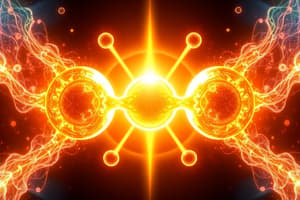Podcast
Questions and Answers
What occurs during the formation of a covalent bond?
What occurs during the formation of a covalent bond?
- Atoms lose electrons to become ions.
- A metallic bond is created between metals.
- Atoms share electrons. (correct)
- Electrostatic attraction between charged ions takes place.
Which of the following is an example of a triple bond?
Which of the following is an example of a triple bond?
- H₂
- Cl₂
- O₂
- N₂ (correct)
What characteristic do ionic compounds typically exhibit when dissolved in water?
What characteristic do ionic compounds typically exhibit when dissolved in water?
- They conduct electricity. (correct)
- They are electrically neutral.
- They have low melting points.
- They form a covalent bond.
What determines the polarity of a covalent bond?
What determines the polarity of a covalent bond?
Which of the following describes the structure of ionic compounds?
Which of the following describes the structure of ionic compounds?
Which type of bond is characterized by the transfer of electrons from one atom to another?
Which type of bond is characterized by the transfer of electrons from one atom to another?
What happens to the bond strength as the number of shared electron pairs increases in covalent bonds?
What happens to the bond strength as the number of shared electron pairs increases in covalent bonds?
Which bond type typically has high melting and boiling points?
Which bond type typically has high melting and boiling points?
Which of the following molecules is nonpolar due to equal sharing of electrons?
Which of the following molecules is nonpolar due to equal sharing of electrons?
Flashcards are hidden until you start studying
Study Notes
Chemical Bonding
Covalent Bonding
- Definition: A type of chemical bond where atoms share electrons.
- Formation: Occurs between nonmetals.
- Characteristics:
- Single Bond: Sharing of one pair of electrons (e.g., H₂).
- Double Bond: Sharing of two pairs of electrons (e.g., O₂).
- Triple Bond: Sharing of three pairs of electrons (e.g., N₂).
- Bond Strength: Generally stronger than ionic bonds; strength increases with the number of shared electron pairs.
- Molecular Compounds: Formed from covalent bonds, often having low melting and boiling points.
- Polarity:
- Nonpolar: Equal sharing of electrons (e.g., Cl₂).
- Polar: Unequal sharing of electrons due to differences in electronegativity (e.g., H₂O).
Ionic Bonding
- Definition: A type of chemical bond formed through the electrostatic attraction between oppositely charged ions.
- Formation: Occurs between metals and nonmetals.
- Characteristics:
- Electron Transfer: Metals lose electrons to become cations, while nonmetals gain electrons to become anions.
- Example: NaCl formation (Na⁺ and Cl⁻).
- Properties:
- High melting and boiling points due to strong ionic interactions.
- Typically soluble in water and conduct electricity when dissolved or molten.
- Crystal Lattice Structure: Ions arrange in a repeating 3D pattern, maximizing attraction and minimizing repulsion.
- Polarity: Ionic compounds are generally considered polar due to the charge separation in ions.
Covalent Bonding
- Covalent bonding involves the sharing of electrons between atoms, typically nonmetals.
- Single Bonds involve one pair of shared electrons (e.g., hydrogen molecule H₂).
- Double Bonds consist of two pairs of shared electrons (e.g., oxygen molecule O₂).
- Triple Bonds feature three pairs of shared electrons (e.g., nitrogen molecule N₂).
- Generally, covalent bonds are stronger than ionic bonds, with bond strength increasing alongside the number of shared electron pairs.
- Molecular compounds formed through covalent bonds usually exhibit low melting and boiling points.
- Polarity in covalent bonds can be categorized as:
- Nonpolar Bonds: Equal sharing of electrons (e.g., chlorine molecule Cl₂).
- Polar Bonds: Unequal sharing due to differing electronegativities, resulting in partial charges (e.g., water molecule H₂O).
Ionic Bonding
- Ionic bonding is characterized by the electrostatic attraction between positively and negatively charged ions.
- Formation typically occurs between metals, which lose electrons to form cations, and nonmetals, which gain electrons to become anions.
- A classic example is the formation of sodium chloride (NaCl), where sodium (Na⁺) and chloride (Cl⁻) unite.
- Ionic compounds are recognized for their high melting and boiling points, attributed to the strong interactions between ions.
- These compounds are usually soluble in water and can conduct electricity when dissolved or in molten form.
- Ionic structures form a crystal lattice, a repeating three-dimensional arrangement that maximizes attractive forces between ions while minimizing repulsion.
- Due to the separation of charges within the compound, ionic compounds are also predominantly classified as polar.
Studying That Suits You
Use AI to generate personalized quizzes and flashcards to suit your learning preferences.




